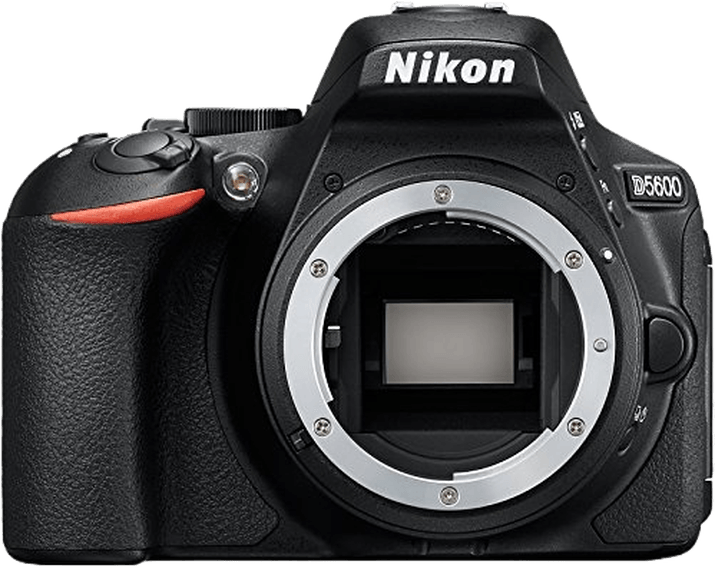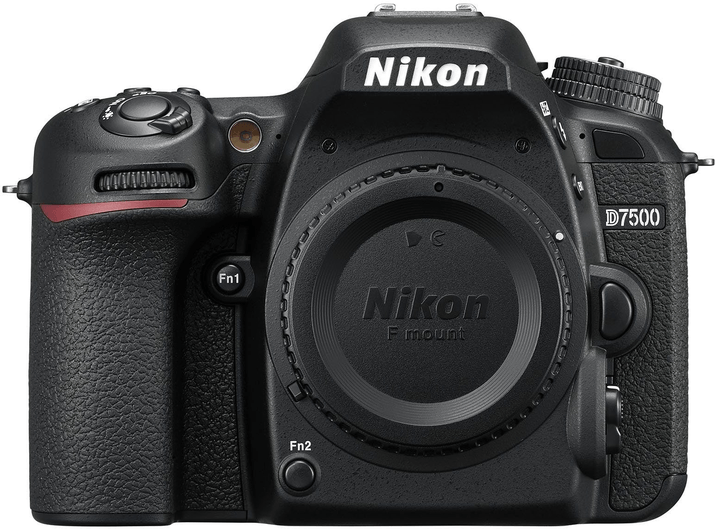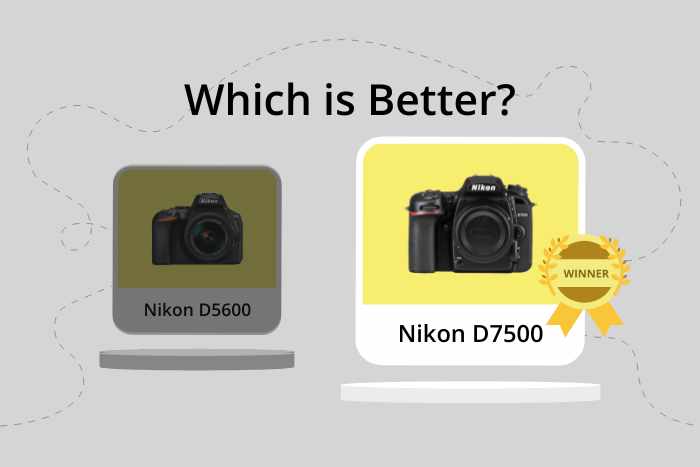Nikon D5600 vs D7500 Comparison
Nikon D5600

Nikon D7500

The Nikon D7500 emerges as the winner with a score of 70/100, while the Nikon D5600 trails behind with a score of 66/100. Both cameras are DSLRs and were released in 2016 and 2017, respectively. They share similarities in design, with the D5600 measuring 124 x 97 x 70mm and weighing 465g, and the D7500 being slightly larger at 136 x 104 x 73mm and 720g.
The D7500’s higher score reflects its superior performance, which justifies its higher launch price of $1250 compared to the D5600’s $700. However, the D5600 holds an advantage in terms of size and weight, making it a more portable and convenient option for photographers on the go.
Taking these factors into account, the Nikon D7500 is a better camera for those seeking higher performance, while the Nikon D5600 is more suited for those prioritizing portability and affordability.
Nikon D5600 vs D7500 Overview and Optics
The Nikon D7500 wins in the optics comparison with a score of 68/100, while the Nikon D5600 scores 65/100. Both cameras share several specifications, such as the APS-C sensor size, Nikon F DX lens mount, and the lack of image stabilization. However, there are key differences that make the D7500 superior in some aspects and the D5600 better in others.
The D7500 has a faster shooting speed of 8 frames per second, compared to the D5600’s 5 frames per second, which makes it better for capturing fast-moving subjects. Additionally, the D7500 has a higher DXOMARK score for the sensor at 86, while the D5600 scores 84, indicating better image quality. The D7500 also has a more advanced processor, the Expeed 5, compared to the D5600’s Expeed 4, which contributes to faster processing and better overall performance.
On the other hand, the D5600 has a higher megapixel count at 24.2, compared to the D7500’s 20.9. This means the D5600 is capable of capturing more detailed images, which can be advantageous for cropping and enlarging photos without losing quality.
Taking these factors into consideration, the Nikon D7500 is better suited for action photography and situations where image quality and performance are crucial. The Nikon D5600, however, is more suitable for those who prioritize high-resolution images for cropping and enlarging. Ultimately, the choice between these two cameras depends on the specific needs and preferences of the photographer.
Nikon D5600 vs D7500 Video Performance
The Nikon D5600 and Nikon D7500 both have a video score of 70/100, indicating that they have similar video capabilities. Both cameras offer time-lapse functionality built in, which is a great feature for creating stunning time-lapse videos.
The Nikon D7500 has an advantage in video resolution, as it can record in 4K with dimensions of 3840 x 2160. This higher resolution results in more detailed and sharper videos compared to the Nikon D5600, which has a maximum video resolution of Full HD (1920 x 1080). The 4K resolution is particularly useful for those who want to create professional-quality videos or for photographers who want to capture more detail in their work.
On the other hand, the Nikon D5600 has a higher maximum video frame rate of 60fps, compared to the Nikon D7500’s 30fps. This higher frame rate allows for smoother video playback and is beneficial for capturing fast-moving subjects, such as sports or wildlife. The D5600’s higher frame rate can also be useful for creating slow-motion videos by slowing down the footage in post-production.
To sum up, the Nikon D7500 has the advantage of higher video resolution, making it the better choice for those seeking more detailed and professional-quality videos. However, the Nikon D5600’s higher maximum video frame rate makes it a better option for capturing fast-moving subjects and creating slow-motion videos. Both cameras have time-lapse functionality built in, which is a great feature for photographers looking to experiment with time-lapse videos.
Nikon D5600 vs D7500 Features and Benefits
The Nikon D7500 emerges as the winner in the features comparison with a score of 83/100, while the Nikon D5600 trails behind at 72/100. Both cameras share several common specifications, including a 3.2-inch touchscreen, flip screen, and the absence of GPS. Additionally, both models are equipped with WIFI and Bluetooth capabilities.
The Nikon D7500 outperforms the D5600 in certain aspects. Despite its lower screen resolution of 922,000 dots, compared to the D5600’s 1,037,000 dots, the D7500’s superior feature score signifies that it offers more advanced functionalities overall. This makes the D7500 a more versatile and powerful option for photographers looking for a camera with a broader range of capabilities.
On the other hand, the Nikon D5600 does have some advantages over the D7500. Its higher screen resolution provides a clearer and more detailed image preview, which can be beneficial for photographers who prioritize image composition and accuracy. However, this advantage is not enough to outweigh the D7500’s overall superiority in features.
In comparing the Nikon D5600 and D7500, it is evident that the D7500 is the better camera in terms of features. While the D5600 does offer a higher screen resolution, the D7500’s comprehensive range of capabilities make it a more suitable choice for photographers seeking an advanced and versatile camera. The Nikon D5600, though trailing in features, still remains a solid option for those prioritizing image composition and clarity.
Nikon D5600 vs D7500 Storage and Battery
The Nikon D5600 and Nikon D7500 have identical storage and battery scores of 43/100. Both cameras feature a single memory card slot, accepting SD, SDHC, and SDXC cards, with the D5600 being UHS-I compatible. Neither model offers USB charging capabilities.
Regarding battery life, the Nikon D5600 holds a slight advantage with 970 shots per charge, compared to the D7500’s 950 shots. The D5600 uses an EN-EL14a battery, while the D7500 uses an EN-EL15a battery. This minor difference in battery life may not significantly impact users’ experiences.
Despite the similarities in storage and battery specifications, neither camera outperforms the other in a substantial way. Both models provide adequate storage options and battery life for most users, making them reliable choices for photography enthusiasts.
Nikon D5600 vs D7500 Alternatives
Still not ready to make a decision? Check out our other popular camera comparisons for inspiration:

